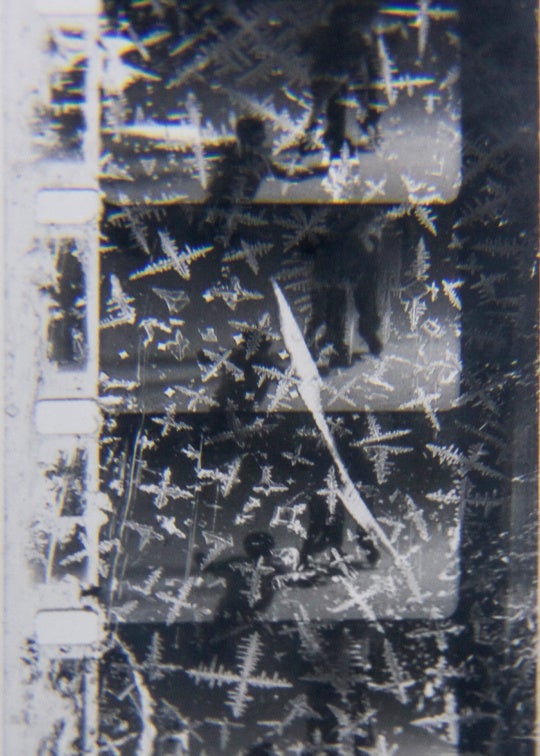
Complex, concentric circles decorated with op art rainbows create the illusion of dimensionality and indeed can mesmerize a viewer. Contemporary advertisers know this trick, and so did the monks and other artisans who proliferated, by hand, incredible mandalas in the Himalayas. The difference, of course, is in intention. From our Western perspective, it seems incredible to imagine employing such powerful graphic techniques toward spiritual enlightenment rather than the sale of a product. But such is the practice of the Tantric Buddhist tradition, whose imagery is the focus of the current exhibition at Emory University’s Michael C. Carlos Museum. Mandala: Sacred Circle in Tibetan Buddhismdisplays a relatively sparse assembly of intensely beautiful mandalas.

Behind the doors of the museum’s upstairs gallery is a mysterious darkened space. Its dim lights protect delicate ground mineral pigments that color the tattered old cotton to which they were laboriously applied. Attendants hover in every room to make sure you do not touch the mandalas. Although implemented as a practical measure of care and preservation, this dramatic environment serves as a cue for the viewer to slow down and be respectful. A feeling of specialness has been conjured: the space itself is a sacred temple. Viewers averse to religious overtones might reject the heavy-handed design, but I was happy to succumb to the fiction of it.

At the center of the exhibition space is a large, newly constructed, three-dimensional mandala made of shiny wood, and throughout the exhibition are interesting ritual objects in vitrines. But for me, the painted Tibetan graphics stole my attention entirely, pulling me deeply into their wild and delicious matrices. To my pleasure, as my nose kept nearly grazing the paintings, an attendant offered me a giant magnifying glass (which he generously let me use as I roamed all four galleries). The instrument proved to be a critical key, for it enabled me to see details acutely.
Perhaps this is how mandalas are useful as meditational tools: their complexity and repetition of detail are overwhelming. One’s attention is repeatedly sidetracked, suspended, and sucked toward seemingly endless labyrinths and crossroads. Artists thus simulate a supernatural state, suspending time and reality. So many buddhas and bodhisattvas (enlightened beings) populate each mandala’s illustrated field, accompanied by halos, cosmic stripes, and temple architecture. Each figure offers its own bundle of tiny details, some quite loose, sexual, or savage. In some instances I was utterly transfixed as the undersides of the smallest arches revealed terrific smeared abstraction. What’s the message? Is it that these higher beings exist at all times, all around us? Or is it a promise that we, too, can join their ranks and tap into the subtler realms? Perhaps the message is that like our own mundane physical existence, these two-dimensional planes unfold into absolute visual bottomlessness upon concentration. And how were the mandala artists able to paint with such tiny precision? They, too, must have employed a magnifying glass, or spectacles, or something. Laboring to produce the minuscule features of these artworks over long periods of time would be likely to induce meditative states. And so, the works are charged with the intense focus of the artists’ hands and minds. It is interesting to consider that such artworks were mass-produced. Many were created in sets ranging from twenty to a hundred.

As with medieval renderings of saints and angels, I assume that the creation of these Eastern infographics did not require particular literacy (I am an outsider to the culture of Buddhism, and yet I get a lot out of it). But as I stood there with my magnifying lens, a docent came through with a class. I overheard her say, “Real appreciation of mandalas [is] reserved for monks. Training by a guru is required for their interpretation.” Reading the descriptions of the paintings gives only an inkling as to their consciously embedded symbolism. But out of context and without mediation from a prescribed religious expert, the mandalas are still quite powerful, and perhaps in a more secular way.
The docent also noted that the art of Tibetan Buddhism represents buddhahood (the general concept of individual enlightenment) as opposed to Buddha, the historical figure. The exact dates of Gautama Buddha’s birth and death are uncertain: some 20th-century historians believe his lifetime occurred circa 563 BCE to 483 BCE. Tantric Buddhism began to emerge in India during the sixth century CE. There are stories that trace the tradition to the time of the Buddha, but it emerged as a distinct cultural phenomenon many centuries after his lifetime. The Tibetan monastic tradition emerged later still, in the fourteenth century, and reflects an abstracted point of view. One might assume that the isolation of Tibet’s high desert geography had a profound impact on this branch of Buddhism. Tibetan religious practices are particularly artful, a fact that Emory University tenderly and consistently promotes as a counterpoint to ongoing threats from Chinese monoculture.

Artworks in the exhibition range in date from the fourteenth century to recent times. A nice move on the part of the curators (this exhibit was organized by the Rubin Museum of Art, New York) are two video mandalas in sweet juxtaposition with these aging paintings and objects. According to the wall text, a number of institutions and ethnological museums began creating simulations of three-dimensional mandalas in the early 1900s. Interestingly, the curators at the Rubin Museum claim that the medium of video is “able to better create transparency and luminescence.” And, after studying the elements of mandalas in the low light of the aforementioned galleries, I can see what they mean. True to the spirit of the original works, the electronic mandalas take it a step further. These modernized visuals make great use of RGB color, which can produce fluorescent green, hot pink, and royal blue on LED screens. In another advantage of the video medium, animations illustrate how the painted mandalas merge two perspectives, not unlike Cubism: an imaginary view from above conjoins with the frontal view. In the static picture, nested circles, triangles, and squares are meant to demarcate the edges of inner rooms. The video mandalas achieve multiple viewpoints with much greater ease. The viewer sees a flat, colorful graphic that rotates or explodes to become a temple with entrances, columns, and towers. The viewer becomes a mouse that travels through every crevice of the structure.
A large time-lapse video of monks making a sand mandala is very hip as well. But of course, seeing the sand mandala in person is far superior to watching it being made on video. The colors of the dyed sand, which are blended in gradients, are absolutely ecstatic. During the course of the exhibit, monks actually came to the space and built this temporary work; onlookers were welcome to watch. And on April 15 it will be destroyed—just another gesture that upholds a spiritual belief about our temporal reality.
One of my favorite paintings in the exhibition depicts Mount Meru, the mythological center of the universe. Represented countless times, this sacred mountain belongs to both Hindu and Buddhist cosmologies. Like the concept that mandalas are both flat graphically and yet also descriptive of temple space, Mount Meru is that magical place where the physical and spiritual meet. The symbolic architecture of the painting is quite geometric and futuristic. Apparently, individual world systems multiply and combine to form massive cosmic clusters such as this one. Modern-looking walls jut out and float in an ellipse of clouds. Blue gradients offset electric orange and baby blue in this psychedelically splendid image.
The mandalas of Tibetan Buddhism constitute a graphic powerhouse from an exotic pre-computer zone. Their makers “employed the mandala visual with an intensity that far exceeds other branches of the religion.” Called “magic circles” or “cosmic diagrams,” mandalas have roots as a meditational aid in Buddhism and Hinduism but ultimately belong to no one.
The Michael C. Carlos Museum’s exhibition, Mandala: Sacred Circle in Tibetan Buddhism, will remain up for display through Sunday, April 15, 2012. The museum is open Tuesdays through Fridays from 10AM to 4PM, Saturdays from 10AM to 5PM, and Sundays from Noon to 5PM.




